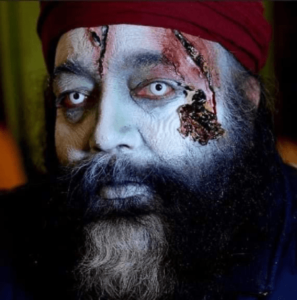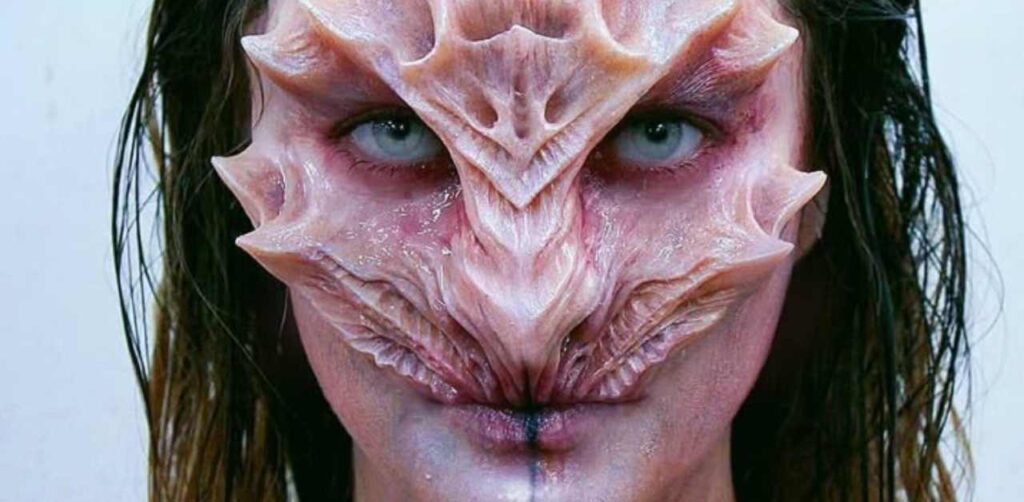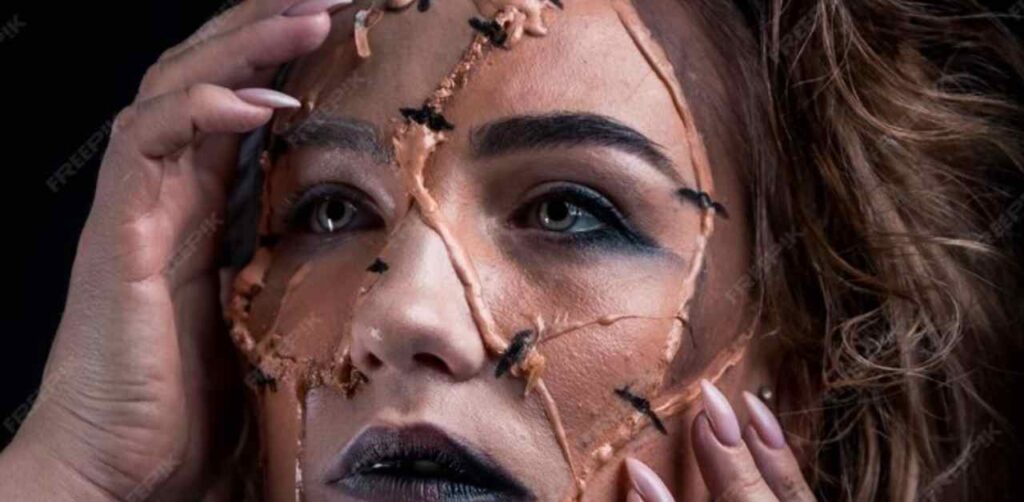What is Prosthetic Makeup?

Prosthetic makeup is a special type of makeup used to change how a person looks by adding artificial body parts to their face or body. These body parts, called prosthetics, are made from materials like silicone, latex, or gelatine. Artists use them to create realistic effects, such as scars, wounds, or even fantasy creatures like aliens or monsters.
The process starts with making a mold of the person’s face or body. Then, the artist sculpts the design, creates the prosthetic, and carefully attaches it to the skin. After that, they use paint and makeup to blend it with the person’s natural features, making it look real.
Prosthetic makeup is often used in movies, TV shows, and theater to create characters that cannot be achieved with regular makeup alone. It helps actors look older, injured, or completely transformed into magical or scary beings. This makeup brings imagination to life, adding excitement and realism to the stories we watch on screen.
History and Evolution of Prosthetic Makeup
Prosthetic makeup has a rich history, starting in the early 1900s when silent film actors used simple materials like wax and putty to create scars and exaggerated features. Lon Chaney, famous for The Phantom of the Opera (1925), was a pioneer, using creative techniques to transform his appearance.
In the 1930s and 1940s, foam latex became popular, allowing for more flexible and realistic effects, seen in classics like Frankenstein (1931) and The Wolf Man (1941).
The 1970s and 1980s were a golden era, with artists like Rick Baker pushing boundaries in films like An American Werewolf in London (1981), showcasing incredible transformations without CGI.
Though computer graphics grew in the 1990s, prosthetic makeup didn’t fade. Instead, artists combined practical effects with digital tools to create even more realistic characters.
Today, prosthetic makeup remains essential in entertainment, from realistic injuries in dramas to fantastical creatures in sci-fi, blending art and technology to bring characters to life.
Difference Between Prosthetic Makeup and Traditional Makeup
| Prosthetic Makeup | Traditional Makeup | |
| Purpose | Changes how someone looks by adding fake body parts like scars, wounds, or fantasy features. | Enhances natural beauty using colors and shades. |
| Materials | Uses silicone, latex, gelatine, and foam. | Uses powders, creams, and liquids. |
| Application | Involves making and attaching molds to the skin. | Applied directly to the face with brushes or sponges. |
| Use | Used in movies and plays to create monsters, aliens, or old-age effects. | Used for daily looks, fashion, weddings, and TV shows. |
| Time | Takes hours or even days to apply. | Can be done in minutes or an hour. |
| Skills | Needs special skills like sculpting and molding. | Focuses on blending colors and contouring. |
| Result | Transforms a person’s appearance completely. | Highlights and beautifies existing features. |
Materials Used in Prosthetic Makeup
Prosthetic makeup relies on special materials to create realistic effects, transforming actors into anything from wounded soldiers to mythical creatures. These materials help makeup artists design lifelike skin textures, scars, and fantasy features that blend seamlessly with the actor’s natural skin. The choice of material depends on the desired effect, whether it’s a subtle aging look or a dramatic monster transformation.
Here are the most commonly used materials in prosthetic makeup:
- Silicone: A flexible and durable material that mimics real skin. It’s popular for creating realistic facial features and is often used in high-budget films and TV shows.
- Foam Latex: A lightweight, spongy material that’s perfect for larger prosthetics like monster masks. It allows movement but needs careful blending with the skin.
- Gelatine: Made from animal by-products, gelatine is soft, translucent, and ideal for creating wounds, burns, and scars. It’s easy to mold and melts away with heat.
- Latex (Liquid Latex): A versatile material used for creating fake skin, wrinkles, and small prosthetic pieces. It’s affordable and great for horror makeup.
- Prosthetic Adhesives: Special glues like spirit gum or silicone adhesive help attach prosthetics securely to the skin.
- Paints and Pigments: Alcohol-activated paints or cream-based makeup are used to color and blend prosthetics with the actor’s skin tone.
- Plastic Bald Caps: Used to hide hair when applying head or face prosthetics, ensuring a smooth surface for makeup.
These materials work together to create believable transformations. Skilled artists sculpt, mold, and paint each piece, carefully blending it with the actor’s real features. The final look depends not only on the quality of these materials but also on the artist’s creativity and precision. This combination of art and science brings some of our favorite movie characters to life.
The Prosthetic Makeup Process
Prosthetic makeup is a step-by-step process that turns imagination into reality, transforming actors into anything from old-aged humans to mythical creatures. It’s not just about putting on fake skin — it’s a careful blend of art and science. Let’s go through the process:
- Concept and Design:
- It all starts with an idea. The makeup artist works with the director to decide the character’s look — like scars, alien features, or animal traits.
- They create sketches or digital designs to plan how the prosthetics will look.
- Life Casting:
- A mold of the actor’s face (or body part) is made using materials like alginate or silicone.
- This step is crucial because it ensures the prosthetics will fit perfectly on the actor’s skin.
- Sculpting:
- The artist sculpts new features — like wrinkles, wounds, or fantasy shapes — onto the life cast using clay.
- This is where creativity shines, as they craft every small detail by hand.
- Molding:
- A mold is created from the clay sculpture using plaster or fiberglass.
- This mold will later be used to produce the actual prosthetic piece.
- Casting:
- Materials like silicone, latex, or foam are poured into the mold to create the prosthetic.
- Once set, the piece is carefully removed and prepped for application.
- Application:
- The prosthetic is glued onto the actor’s skin using special adhesives like spirit gum or silicone glue.
- The edges are blended with the actor’s real skin to make it look seamless.
- Painting and Detailing:
- The prosthetic is painted to match the actor’s skin tone using specialized paints.
- Details like scars, veins, or bruises are added to make it look lifelike.
- Final Touches:
- Additional elements like fake hair, teeth, or contact lenses are added.
- The final look is checked under proper lighting to ensure it appears realistic on camera.
The prosthetic makeup process is all about patience, creativity, and skill. Each step plays a key role in bringing fantasy to life, making characters look believable and impactful. Without this art form, many iconic movie monsters and fantasy heroes wouldn’t exist!
Types of Prosthetic Makeup Effects
Prosthetic makeup effects go beyond traditional makeup, using sculpted pieces to create realistic or fantastical transformations. Let’s explore the main types of prosthetic makeup effects in detail:
1. Aging Effects
Aging effects are used to make a person look older or younger than they really are. This technique is often used in movies, TV shows, and theater to show the passage of time or to portray elderly characters.
- Life Casting: A mold of the actor’s face is made to design prosthetics that fit perfectly.
- Sculpting: Artists sculpt realistic age lines, deep wrinkles, and sagging skin using clay.
- Prosthetic Pieces: These are made from materials like silicone or foam latex to mimic real skin texture.
- Application: Prosthetic parts are glued and blended into the skin to create natural-looking wrinkles and folds.
- Painting: Skin tones are matched, and details like age spots, veins, and discoloration are added.
- Final Touches: Grey hairpieces, false eyebrows, and dentures complete the transformation.
Aging effects help show time jumps in movies, create fantasy aging (like ancient wizards), and add realism for elderly characters.
2. Injury and Wound Effects
Injury and wound effects are used to create realistic cuts, burns, bruises, and scars. This type of prosthetic makeup is crucial in action movies, horror films, and medical dramas.
- Design: Artists study real injuries to replicate them accurately.
- Molding and Casting: Wounds are sculpted and molded, then cast using flexible materials.
- Application: Prosthetics are glued onto the actor’s skin.
- Blending: The edges are smoothed to merge with the skin seamlessly.
- Painting: Blood, bruising, and tissue details are painted on using alcohol-activated paints.
- Blood Effects: Special gels and fake blood may be added for a fresh wound effect.
These effects can range from subtle scars to extreme gore, helping to add drama and intensity to a scene.
3. Creature and Fantasy Transformations
Creature and fantasy transformations turn actors into monsters, aliens, or mythical beings. This type of prosthetic makeup is common in sci-fi, fantasy, and horror genres.
- Concept Design: Artists work with directors to design the creature’s look through sketches and 3D models.
- Life Casting: Molds are made of the actor’s face and body.
- Sculpting: Fantasy features like horns, scales, or tentacles are sculpted onto the molds.
- Prosthetic Creation: Using silicone, latex, or foam, the pieces are crafted.
- Application: The prosthetics are layered onto the actor’s skin.
- Detailing: Skin textures, patterns, and vibrant colors are painted on.
- Final Touches: Hair, claws, and glowing eyes may be added.
These effects create realistic non-human appearances, allowing actors to fully embody their roles in otherworldly stories.
4. Gender Transformations
Gender transformations use prosthetic makeup to alter an actor’s facial structure and body features to portray a different gender. This is used in films, theater, and even drag performances.
- Facial Sculpting: Cheekbones, jawlines, and noses are reshaped with prosthetics.
- Body Modifications: Chest pieces, hip pads, and other body prosthetics help create realistic silhouettes.
- Application: Prosthetic pieces are blended into the skin for natural results.
- Makeup: Contouring enhances or softens features to match the desired gender presentation.
- Hair and Accessories: Wigs, facial hair, and other accessories complete the look.
These transformations can be subtle or dramatic, helping actors authentically portray characters of any gender.
Prosthetic makeup is a powerful tool in the entertainment industry. Whether aging a character, creating a fearsome creature, or transforming gender appearance, these effects bring imagination to life in the most realistic way possible.
Tools and Equipment Needed
| 🛠️ Tool/Equipment | 🎯 Purpose |
| 🏺 Life Casting Materials | Used to create molds of actors’ faces/bodies for custom prosthetics. Common materials include alginate and silicone. |
| 🎨 Sculpting Tools | For shaping clay models of prosthetics, adding fine details like wrinkles, scars, or fantasy elements. |
| 🧪 Molds and Molding Kits | To cast prosthetics using materials like latex, silicone, or foam latex. |
| 🩹 Adhesives (e.g., Pros-Aide, Spirit Gum) | To glue prosthetic pieces securely onto the skin. |
| 🧴 Removers (e.g., Isopropyl Myristate) | Used to safely remove prosthetics without damaging the skin. |
| 🌈 Airbrush and Paints | For coloring prosthetics, blending them with natural skin tones, and adding details like veins or bruises. |
| 🖌️ Brushes and Sponges | Essential for painting, blending, and texturing prosthetic pieces. |
| 🔒 Sealers and Setting Sprays | To lock in makeup and prevent smudging during long shoots. |
| 👩🦳 Hairpieces and Wigs | Often used to complement prosthetic looks, like adding age with gray hair or fantasy elements like fur. |
| 🩸 Special FX Blood and Gels | For realistic wound effects, adding wet-looking blood, or making scars appear fresh. |
| 🔥 Heat Guns and Hair Dryers | Speed up the drying process for adhesives and paints. |
| ✂️ Scissors and Craft Knives | For cutting, trimming, and refining prosthetic pieces. |
Famous Examples of Prosthetic Makeup in Movies and TV
Dustin Hoffman – Little Big Man

Image Credit- screenrant.com
Winona Ryder – Edward Scissorhands

Image Credit- screenrant.com
Importance of Prosthetic Makeup in the Entertainment Industry
Prosthetic makeup plays a vital role in the entertainment industry, helping bring imaginative characters and realistic effects to life. Its significance goes beyond just appearance — it influences storytelling, character depth, and audience engagement. Let’s break down why prosthetic makeup matters:
- Character Transformation: Allows actors to physically transform into creatures, aging characters, or fantasy beings, adding realism to their roles.
- Enhancing Storytelling: Brings authenticity to scenes, whether it’s creating battle scars, fantasy monsters, or historical figures.
- Pushing Creative Boundaries: Encourages innovation by allowing makeup artists to blend prosthetics with CGI, creating stunning visual effects.
- Immersive Audience Experience: Helps viewers believe in the fictional worlds and characters, strengthening emotional connections.
- Award-Winning Art: Recognized as a crucial art form, often earning accolades at major award shows like the Oscars and Emmys.
Without prosthetic makeup, many iconic characters and memorable cinematic moments would lose their magic. It’s a perfect blend of art and technology that continues to push creative limits in entertainment.
Career in Prosthetic Makeup in 2025
A career in prosthetic makeup offers creative opportunities in movies, TV shows, theater, and live performances. To succeed, aspiring artists need artistic talent, an understanding of anatomy, and specialized training. Building a strong portfolio and gaining hands-on experience through internships is essential. Networking with industry professionals also helps in securing projects.
For those passionate about mastering prosthetic makeup, THE RIYA VASHIST Makeup School provides professional Prosthetic Makeup training.
Riya Vashist is an internationally trained Prosthetic FX and Special Effects Makeup Artist, with expertise gained from Hollywood, USA. She specializes in creating realistic character transformations and special effects for movies, theater, and professional productions. At her makeup school, students learn everything from concept design to final execution, ensuring they are fully prepared for the industry.
To learn more about Riya’s work and training programs, visit prostheticmakeup.in.
Conclusion
Prosthetic makeup is more than just an art—it is a powerful tool in the entertainment industry that brings imagination to life. From creating realistic aging effects to designing fantasy creatures, it plays a key role in storytelling and character development. As technology evolves, the future of prosthetic makeup continues to push creative boundaries. For those passionate about this craft, proper training and hands-on experience are essential. Schools like THE RIYA VASHIST Makeup School provide the perfect foundation to master these skills and build a successful career. Whether you’re an aspiring artist or simply curious about the magic behind the scenes, prosthetic makeup remains a fascinating blend of creativity, science, and storytelling.
FAQs About Prosthetic Makeup
How is prosthetic makeup different from traditional makeup?
Traditional makeup enhances natural features, while prosthetic makeup alters an actor's appearance completely — adding scars, aging effects, or fantasy elements.
What materials are used in prosthetic makeup?
Common materials include silicone, latex, foam latex, and gelatine, along with adhesives, paints, and removers.
How long does prosthetic makeup take?
It depends on the complexity — simple effects may take an hour, while full character transformations can take 4-8 hours.
Is prosthetic makeup safe for the skin?
Yes, when done professionally. High-quality materials and proper skin preparation help avoid irritation or allergic reactions.
Can prosthetic makeup be reused?
Most prosthetic pieces are designed for single use due to their delicate nature, but some durable silicone pieces can be reused with care.
Can anyone learn prosthetic makeup?
Yes! With proper training, creativity, and practice, anyone passionate about special effects makeup can learn and master the craft.
Where can I learn prosthetic makeup?
You can learn at specialized schools like THE RIYA VASHIST Makeup School, which offers professional training in Prosthetic FX and Special Effects Makeup.


